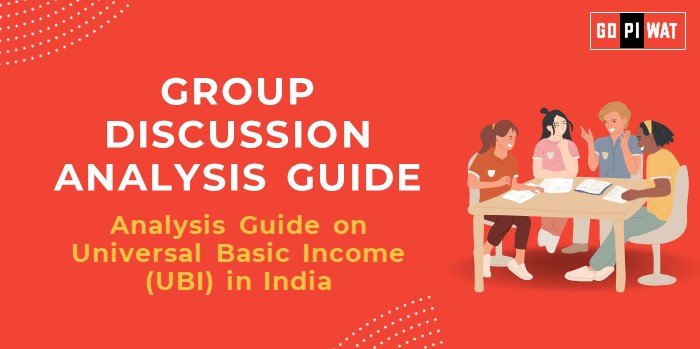📋 Group Discussion (GD) Analysis Guide on Universal Basic Income (UBI) in India
🌐 Introduction to Universal Basic Income
Opening Context: Universal Basic Income (UBI) is a welfare mechanism designed to provide regular, unconditional cash payments to all citizens, addressing poverty, unemployment, and social inequality. With India’s vast income disparities, the feasibility of UBI has garnered significant attention among economists, policymakers, and social reformers.
Topic Background: The concept of UBI has roots in both economic theory and social justice frameworks. Recently, it has gained traction globally as automation and economic displacement grow. In India, where over 22% of the population lives below the poverty line, UBI offers a potential alternative to traditional welfare schemes. The 2017 Economic Survey recommended a quasi-UBI for India, sparking widespread debate on its viability.
📊 Quick Facts and Key Statistics
- 💸 Cost of Implementation: Implementing a basic UBI in India would cost approximately ₹4–6 lakh crore annually, which is 3-5% of the GDP, posing significant fiscal challenges.
- 📈 Poverty Reduction Impact: UBI pilot projects in Madhya Pradesh with 6,000 recipients showed a 12% increase in school attendance and improved health and nutrition outcomes.
- 🔧 Administrative Efficiency: UBI could simplify welfare by replacing over 950 subsidy schemes, potentially reducing administrative costs by 30% and minimizing exclusion errors affecting 90 million Indians.
- 🌾 Agriculture Sector Dependence: According to the Economic Survey 2023-24, the agriculture sector supports 42.3% of the population but contributes only 18.2% to GDP, indicating low productivity. A UBI could provide a financial cushion for surplus agricultural workers, encouraging a shift to higher-productivity sectors, similar to economic transformations in South Korea and other East Asian nations.
- 📊 Pilot Project Outcomes: In SEWA’s Madhya Pradesh UBI pilots, adults received ₹300 and children ₹150 monthly, resulting in a 45% debt reduction and a threefold increase in self-employment activities.
👥 Stakeholders and Their Roles
- 🏛️ Government: Responsible for UBI’s financial planning, policy framework, and addressing potential impacts on existing welfare schemes.
- 🏢 Private Sector: Could contribute to UBI funding through corporate social responsibility initiatives or taxation.
- 👨👩👧👦 Citizens: Both recipients and contributors (through taxes), whose purchasing power and savings could improve under UBI.
- 🌍 International Organizations: Offer expertise and funding; agencies like the World Bank could support studies or pilot projects.
- 📢 Civil Society: NGOs and advocacy groups play a role in pilot projects, data collection, and awareness on UBI’s social benefits.
🏆 Achievements and Challenges
✨ Achievements:
- 🚀 Pilot Success: Positive outcomes in Madhya Pradesh and Sikkim pilots, including improved health, education, and gender empowerment.
- ⚙️ Economic Transition Potential: With over 42% of India’s labor force in low-productivity agriculture, UBI could facilitate a shift towards more productive sectors, accelerating economic modernization similar to South Korea’s transition.
- 📊 Administrative Efficiency: Reduces complexity by replacing multiple welfare schemes, potentially saving 30% in administrative costs.
⚠️ Challenges:
- 💰 Financial Feasibility: Funding UBI would require significant tax reforms or reductions in subsidies.
- 📉 Inflation Risk: Direct cash transfers could lead to inflation, particularly in rural areas.
- 🌍 Global Comparison: Finland’s trial showed UBI reduced financial stress but had minimal effect on employment.
- 📊 Case Study: In Madhya Pradesh, UBI’s positive impact raised concerns about long-term fiscal sustainability for states.
💬 Structured Arguments for Discussion
Supporting Stance: “UBI could provide a financial cushion to help India’s surplus agricultural workers transition to more productive sectors, boosting economic modernization.”
Opposing Stance: “With India’s current fiscal constraints, implementing UBI nationwide may not be feasible without significant budget restructuring.”
Balanced Perspective: “UBI could be feasible if implemented in phases, targeting vulnerable groups first, and adjusting based on economic impact.”
🗣️ Effective Discussion Approaches
- 📊 Opening Approaches:
- Data-Driven Start: “With 42.3% of the population in agriculture contributing only 18.2% to GDP, UBI offers an opportunity to support workers transitioning to higher-productivity sectors.”
- Comparative Approach: “While global UBI pilots have shown positive outcomes, India’s fiscal and demographic landscape presents unique challenges for UBI.”
- 🛡️ Counter-Argument Handling: Reference SEWA’s pilot success in Madhya Pradesh, where UBI encouraged self-employment and financial stability, providing an economic cushion for workforce shifts.
🔍 Strategic Analysis of Strengths and Weaknesses (SWOT)
🔹 Strengths:
- ✨ Simplifies welfare; empowers informal workers; potential to support economic transition from agriculture.
🔹 Weaknesses:
- 💸 High implementation cost; risk of inflation; dependency concerns.
🔹 Opportunities:
- 🌟 Supports job shifts from agriculture to productive sectors; potential for public-private funding.
🔹 Threats:
- ⚠️ Political opposition; economic and inflationary impact; fiscal sustainability.


